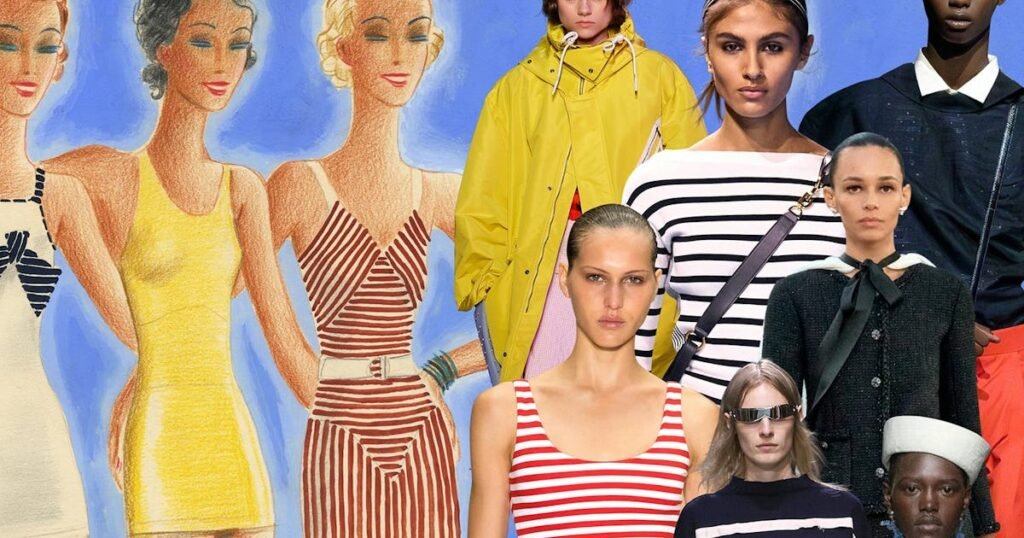Fashion
Why Fashion Is Having a Maritime Moment
Ahoy! Breton stripes at Prada and Dior. Sailor suits at Chanel and Moschino. Yacht-ready girls at Alaïa. DIY flotation devices at Duran Lantink. It was all fair winds and following seas for maritime looks on the spring 2025 runways. The fashion tides ebb and flow all the time, so to what do we owe this particular flood of enthusiasm for seafaring style? A collective case of “Customers also watched Follow the Fleet” on Prime Video? Or is it a reaction to climate change—designers prepping jaunty looks to meet the rising sea levels?
Probably neither. Despite its inherent kitsch factor, nautical attire, with its roots in military garb, falls under classicism within the fashion canon. Designers love a uniform for myriad reasons—it hints at ceremony, romance, and the opportunity for subversion. Uniforms are also highly designed. Stripes, adopted because they were easy to spot when a man fell in the water, have been synonymous with the navy since the 19th century. The tricot raye, or Breton striped shirt, became part of the French naval uniform in 1858; each garment had exactly 21 blue stripes, one for each of Napoleon’s victories at sea over the British.
At around the same time, in Britain, Queen Victoria was sailing the Channel Islands on the royal yacht when she had the adorable idea to have a sailor suit made for 4-year-old Albert Edward, also known as “Bertie,” the future King Edward VII. His father, Prince Albert, was so tickled by the sight of the royal tyke in uniform that he commissioned a portrait by Franz Xaver Winterhalter as a Christmas gift for the Queen. In 1847, it was exhibited at St. James’s Palace, where it drew an audience of more than 100,000. The portrait sparked a Victorian children’s wear trend that was also embraced by the Americans and the Japanese; the latter even implemented sailor dress, or seifuku, as the uniform for middle and high school students. In England, the tradition has remained alive and well in the royal family. Princess Diana dressed princes William and Harry in sailor suits when they were children. For Trooping the Colour in 2022, Prince Louis wore the same outfit his father, William, had worn more than three decades prior.
In the annals of high fashion, Coco Chanel is often credited with taking Breton stripes out of the navy and into civilian life. In 1912, she opened a boutique in the beach town of Deauville, drawing inspiration from the seaside leisure sports. The light practicality of sailor pants and marinières was key to her groundbreaking androgynous style, and these items were eventually incorporated into Chanel’s house codes.
Decades later, Chanel’s fellow French provocateur Jean Paul Gaultier made sailor stripes a cornerstone of his design vocabulary. “My grandmother used to dress me in Breton tops, so when I think of navy stripes I feel a nostalgia for that era when I was growing up,” he once said. “At the beginning of the 1980s, I started wearing the Breton stripe top again. I wore them everywhere, even with a tuxedo for gala evenings.” Gaultier famously appropriated the marinière for his 1983 men’s collection, “L’Homme Objet” (“Boy Toy”). Inspired by Rainer Werner Fassbinder’s erotic sailor movie, Querelle (1982), Gaultier had models in highly sexualized cropped and backless versions of the shirt. By the 1990s, the designer’s favorite motif was immortalized on the bottle for his fragrance Le Male: a torso clad in Breton stripes. When a trend crosses over to fragrance—the ultimate revenue driver for a majority of fashion houses—you know it has longevity.
Whether inspired by the leisure class, the working man, or sexy sailors, maritime style has always been defined by graphic clarity, the simplicity of primary colors, and functional tailoring. With this trend, there’s no such thing as going overboard.

